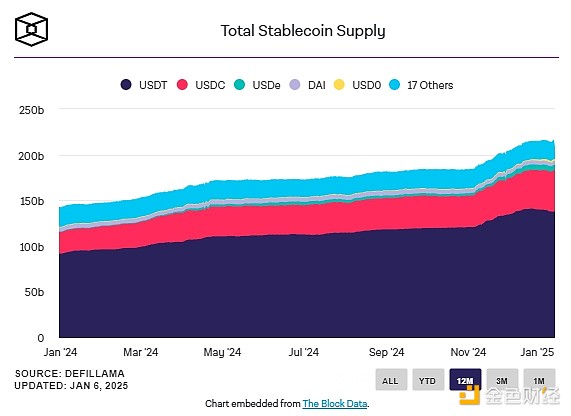Author: James Hunt, The Block; Translated by: Wuzhu, Golden Finance
As we enter the first full week of 2025, analysts at research and brokerage firm Bernstein make 10 predictions for the year ahead as cryptocurrencies enter what they describe as the "Age of Infinity."
The Age of Infinity is "a long period characterized by continued evolution and widespread acceptance, and ultimately cryptocurrencies are no longer controversial — just part of a financial system built for the new smart age," analysts led by Gautam Chhugani wrote in a note to clients on Monday. "Don't expect a boom-bust pattern," he said. “Cryptocurrencies are now firmly on the radar screen of corporations, banks and institutions, woven into the fabric of our financial system.”
Analysts reiterated their price target for Bitcoin of $200,000 by the end of 2025 following President-elect Donald Trump’s campaign pledge to hold strategic Bitcoin reserves. While analysts are unsure whether states will make actual purchases a legislative priority starting this year, they do expect corporate adoption to continue to grow, with inflows expected to exceed $50 billion in 2025, compared with $24 billion last year. MicroStrategy is likely to lead demand again, followed by bitcoin miners expanding capital plans and small and midsize companies looking to emulate Michael Saylor's model, analysts said.
They also predict that U.S. spot Bitcoin ETFs will attract more than $70 billion in net inflows — double the roughly $35 billion expected in 2024 — driven primarily by accelerated institutional adoption by hedge funds, banks and wealth advisors, with holdings surging to 40%, compared to just 22% of ETF investments in the third quarter of last year. In addition, the analysts expect the Bitcoin ETF whitelisting process to continue, the continued presence of leading national integrated banks and private banking platforms, continued momentum for Bitcoin and Ethereum ETFs, and a possible Solana ETF by the end of the year.
“The U.S. announcement of a national Bitcoin reserve will spark a global race for sovereigns to buy Bitcoin. Our $200,000 Bitcoin price forecast does not factor in government demand — only institutional and corporate demand,” Chhugani said. “As corporate treasuries and Bitcoin ETFs become a larger component of Bitcoin ownership, we expect Bitcoin ownership to become more solid. Therefore, if Bitcoin lingers below $100,000 for a longer period of time, Bitcoin will switch hands from traders/sellers to long-term holders such as MicroStrategy and Bitcoin ETF holders.”
On Bitcoin, the analyst said miners “must” continue to shift capacity to AI to create value. There is a significant difference in the performance of AI diversified companies and “pure” Bitcoin miners in 2024. The analyst pointed out that AI diversified companies such as Core Scientific and TeraWulf have achieved gains of 308% and 136% respectively this year, while Riot Platforms and CleanSpark have lost 34% and 17%, respectively. They expect this trend to continue as “AI transforms the bitcoin mining business model, making it more sustainable and less cyclical, thereby bringing in a broader institutional investor base.”
Continuing with the AI theme, Bernstein analysts expect closer integration with the crypto industry this year, and the intersection of AI and crypto is spurring innovation on multiple fronts. Key developments include decentralized AI blockchains for computation, storage, and inference, as well as “proof-of-human” identity authentication services, AI-integrated crypto wallets, and tokenized AI agents.
Stablecoin market size reaches $500 billion, SEC withdraws cryptocurrency case, etc.
Bernstein analysts expect that as pro-cryptocurrency governments come to power, the industry will usher in "unprecedented" regulatory tailwinds this year, including possible legislation on stablecoin and digital asset market structure, and further clarification of the definition of "crypto securities."
"The stablecoin bill will be considered a priority.Stablecoins further strengthen the dollar by purchasing Treasury bonds and distributing digital dollars online," said Chhugani. “The digital asset market structure facilitates legal clarity and licensing for exchanges, broker/dealers, including the legal status of non-custodial DeFi protocols by excluding them from broker/dealer status. Finally, it limits the definition of crypto-security and allows the CFTC to exercise greater oversight over most digital assets except for a small subset of digital asset securities.”
Such legislation in the U.S. could drive significant growth in the global stablecoin market, which analysts predict will exceed $500 billion by 2025, more than double the 55% growth in 2024 to over $200 billion, as its applications extend beyond the cryptocurrency industry, particularly in global cross-border B2B payments and cross-border remittance solutions.

In addition, analysts expect that the more crypto-friendly U.S. Securities and Exchange Commission will withdraw or resolve existing cases with cryptocurrency companies and allow more private cryptocurrency companies to enter the public market, and IPOs will become a further positive catalyst for the market. They also expect that cryptocurrency exchanges and platforms such as Robinhood will tokenize the stock market, thereby enabling 24/7 liquid stock market trading based on blockchain technology, and banks and asset management companies will also launch more cryptocurrency-related products.
Finally, Chhugani said that despite last year's poor performance, Ethereum is expected to become the next "institutional darling" by 2025. With 28% of Ethereum staked, 3% absorbed by ETFs, and 7.5% locked in smart contracts, the analyst said Ethereum's limited supply and utility as a fee payment and collateral asset for layer 1 and layer 2 chains make it attractive to traditional investors seeking intrinsic value.
 Catherine
Catherine







